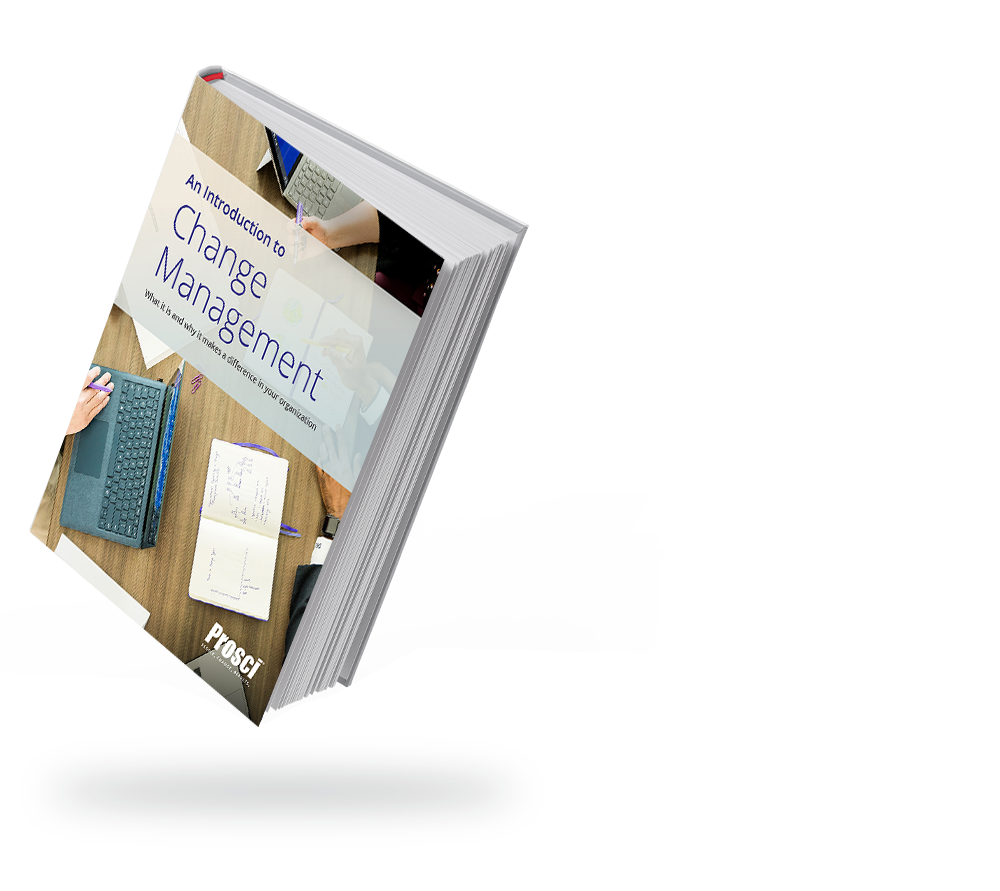Get to know the Prosci change management process in a nutshell
All you need to know to start with the Prosci Methodology in one place
All you need to know to start with the Prosci Methodology in one place
Implementing a change is never straightforward.
While resolving the technical aspects is a significant milestone, it is only one part of the challenge.
What is missing, then?
The people side of change.
When not overlooked, this aspect often proves to be very intimidating.
The fact is that many people need to step in, decide, communicate, coach or be coached for organisational change to happen and last.
Are you unsure about who should be doing what, when, and how?
And do you want to know what it takes for people to engage with the change on a deep level?
We have compiled everything you need to kickstart your journey with the Prosci change management process right on this page.
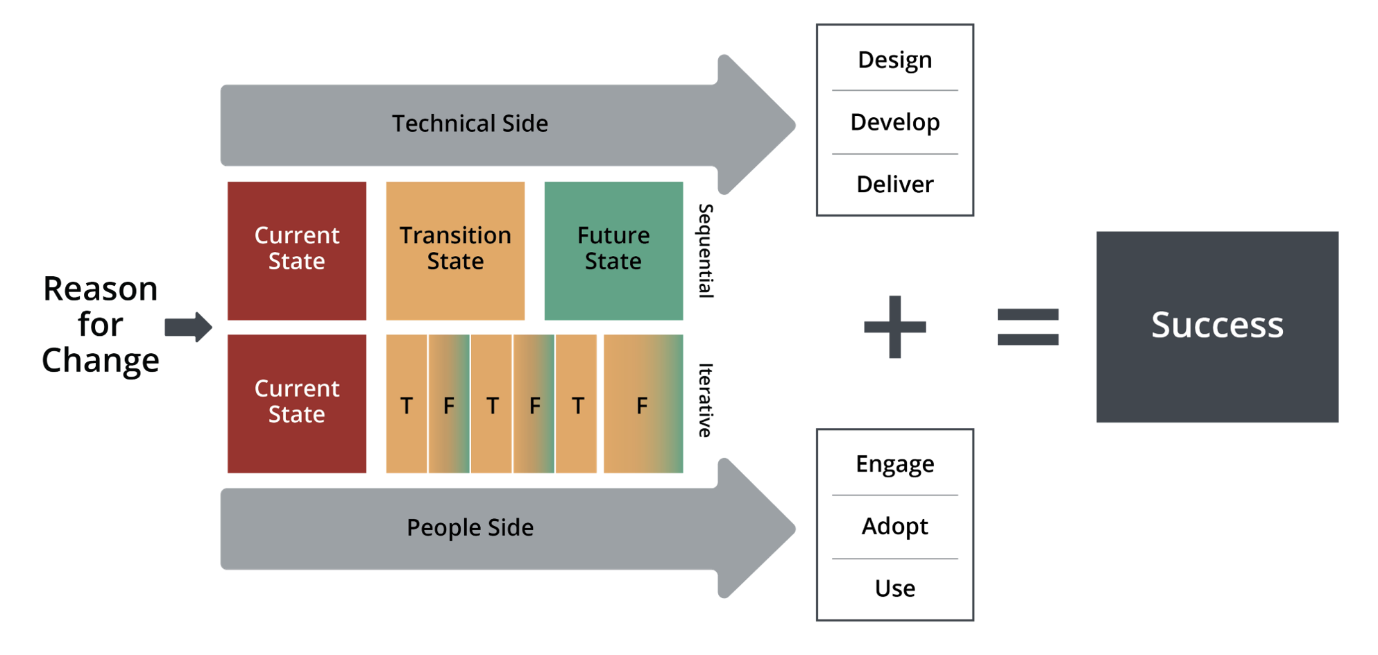
Prosci has streamlined the change management process.
Drawing on the insights of thousands of change practitioners around the globe, it distils the best practices and makes them readily accessible to you.
The Prosci Methodology provides a comprehensive framework, a roadmap and a full suite of tools to help you get clarity on your organisational goals and achieve them on schedule and on budget.
The method is structured upon three core components:
You might have heard of ADKAR, Prosci's core foundational model for individual change, but how familiar are you with the overarching structure for organisational change?
To walk you through the complete method, we start each section or subsection with a set of key questions.
When applied to a real-life project, they serve as a guiding compass, propelling the project forward with the full participation of all stakeholders.
Learn everything from A to Z, starting with the project's initial alignment.
What does organisational success look like? How do you know if your project is on track and remains so?
The PCT is a fundamental model for a reason: it acts as your Northern Star, helping you set the direction of the project and keep it on its tracks until it reaches the “future state”.
Four critical aspects contribute to the success of any change initiative.
These components must always remain robust, as any weaknesses could hinder progress and eventually result in failure.
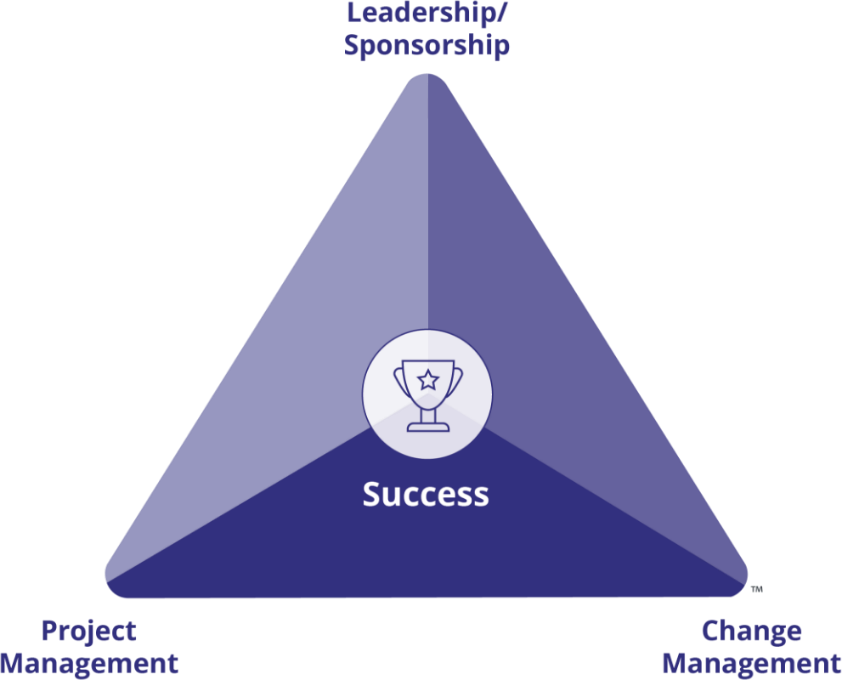
The PCT is a powerful tool to gauge the level of alignment of the three driving forces of organisational change - leadership, project management, and change management - around a shared and well-defined definition of success. As such, the PCT helps design corrective measures before you even start managing the change.
Let’s quickly explore the triangle above:
When implementing a change management strategy, it is crucial to have a clear vision of success (the future state), including the reasons for the change, the organisational goals and expected benefits.
This aspect focuses on understanding who is accountable for defining the purpose of the change, how it aligns with the goals, and why it is a priority.
PM involves designing, developing, and delivering a solution (the famous 3 Ds) that solves a problem, all within time, cost, and scope constraints.
CM is about empowering people and boosting the adoption and proficient use of the solution developed by PM.
You will use the PCT more than once!
The PCT comes before, during and after the project is complete, ensuring a consistent approach and steadfast progress.
In short, the PCT is found in each phase of the Prosci change management process, starting with Phase 1, preparing the approach.
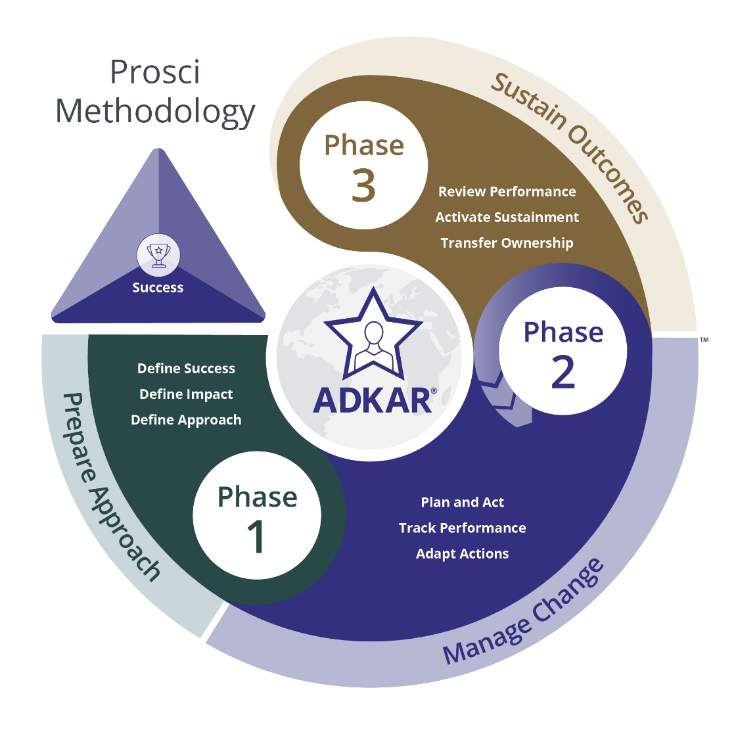
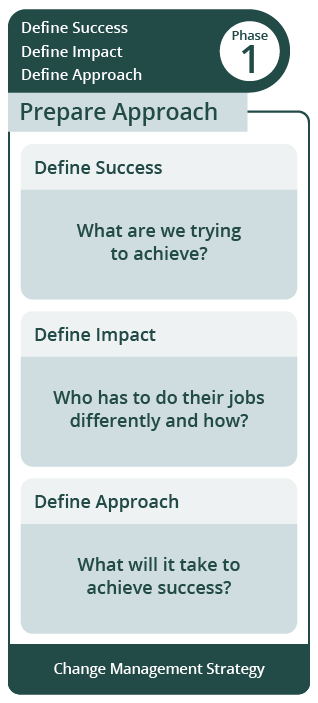
What you will be doing: Create a strategy. Get clarity on your goals and the means to move the organisation closer to the future state.
Phase 1 is designed to help change and project management teams give precise answers to the following three questions:
As we have just said, the PCT is the tool that will help you jumpstart the whole process. It involves creating a detailed change profile, specifying the goals and what success looks like.
The change might impact different groups in different ways. You need to map out the impact and set a target for adoption and usage.
Once you have gained a granular understanding of the change and its impact on specific groups, it is time to formulate a set of actionable steps to bridge the gap between the current and the future state. That means creating a roadmap, assessing risks, anticipating resistance, and defining roles.
With a comprehensive and robust strategy to maximise results, you are fully prepared for Stage 2, managing the change.
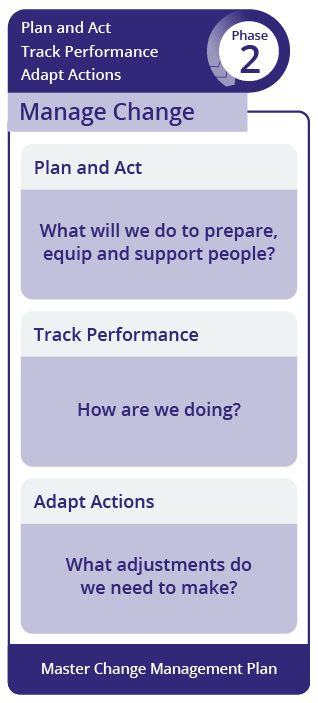
What you will be doing: Put your strategy into action to navigate the change seamlessly.
Remember that organisational change is the collective result of all individual transitions - the core principle of ADKAR. Phase 2 is about guiding the people and the organisation through each step of the continuum: creating Awareness, nurturing Desire, delivering Knowledge, securing Ability, and finally, Reinforcing. Similar to Phase 1, Phase 2 is broken down into three distinct stages: :
Make sure no one can ever be left behind. You must now figure out how to prepare, equip, and support everyone. This part typically involves developing an ADKAR Blueprint and change management plans, including a Sponsor Plan and Communications Plan.
Your main goal here is to monitor progress and maintain momentum.
Common tasks include setting up a tracking calendar to monitor advancements and identify strengths and improvement opportunities.
You probably gathered many insights from the previous stages. Adjust the strategy as needed to improve or course-correct and keep tracking performance.
Phase 2 requires careful planning and performance monitoring. However, be cautious, as Stage 3 of this phase often lures many organisations into a common pitfall: rushing to the next change without taking the time to cement their achievements.
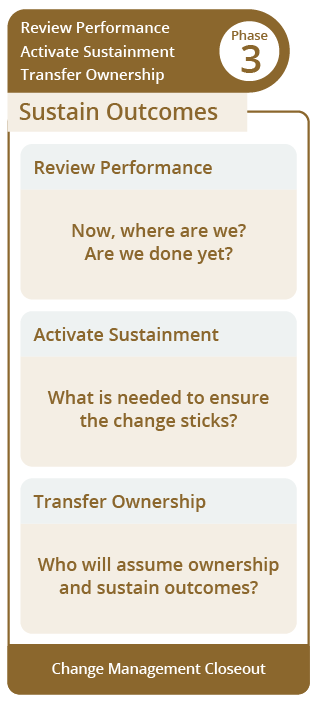
What you will be doing: Take proactive measures to make the change stick.
Neglecting Phase 3 can be very costly.
Without solid reinforcing strategies, only a mere 17% of change projects actually deliver on their promises.
But with successful sustainment, that number skyrockets to an impressive 70%.
Find out whether everyone has successfully completed his or her own personal transition. By evaluating the results of the ADKAR model post-implementation and capturing valuable lessons learned, you can ensure that the project has delivered on its promises.
Identify gaps or areas that need improvement and develop plans to address them. People can quickly fall back into old habits. Inertia is hard to beat. Make sure you have resources and support systems to sustain the change.
Long-term success and lasting change require someone to continue steering the ship in the right direction, even when CM practitioners have shifted their focus toward new projects. Transfer knowledge and assets to designated individuals and teams. And the most exciting aspect: celebrate achievements!
Positive reinforcement is always effective.
Phase 3 concludes the change process with final performance reviews, sustainment actions and ownership transfer.
Flexible, scalable and intuitive, the 3-phase process is all you need to succeed at any change.
With its robust research-based solutions, intuitive tools, and models, Prosci has earned the trust of change practitioners worldwide. Most importantly, its methodology constantly evolves to help you stay ahead of the curve:
The Prosci Methodology is fueled by real-world experiences and insights from thousands of change leaders worldwide. With over two decades of shared successes, failures, and lessons learned, this methodology delivers consistent results. It will do the same for any of your ongoing and future projects.
Prosci provides easy-to-use, comprehensive solutions to complex and fragmented problems. Well-structured, adaptable and repeatable, the Prosci change management process helps you move quickly from theory to practice.
Change can be measured. Prosci has established clear benchmarks to monitor performance and track progress.
Stay abreast of the discipline and be change-ready. Active learning is made easy with a rich stream of webinars and tutorials.
The Prosci Methodology puts people first. Change is more than just a process; it is about truly understanding who makes the change and solving human challenges with human support.
With partners in over 50 countries and still expanding, Prosci is the leader in change management solutions. Get a seasoned partner, and tap into the industry’s largest body of change management research in the world.
Keep exploring with our introductory book, webinars and blog posts. We have a lot to say.
Upgraded Tools to successfully Manage the Change, with PROSCI.
Joining us right now or just discovering this series? We are halfway through PROSCI 3-phase process. Our last blog offered plenty of advice on how to design the "best fitted" approach to preparing for the change with PROSCI's refreshed Methodology. Let's now dive into the nuts and bolts of Phase 2: "Managing the change". In this fourth instalment, you'll learn how to drive adoption and utilisation by creating, implementing and adapting plans to help people and the organisation navigate ADKAR transitions. Managing the change is the art of connecting the "how" to the "who". Organisations don't change. People do. Get familiar with the new ADKAR Blueprint for structuring the change. Discover a refreshed set of Change Management plans. Find out how to track your performances to optimise for success and adapt your plans to stay the course. Plan and act. Key question: What will we do to support ...
Written by
Morten Kamp Andersen
Change Management: Results With and Without. A Case Study.
Prosci Europe's case studies offer practical insights for organisations wishing to make changes that stick. Executive Summary Why should I read? To get a real-life example of what can happen without a structured approach to managing the change. We uncover the difference in outcome between two organisations seeking to deploy the same technological solution to a recurrent and common issue in the personal care service sector. Highlights: In one case, the implementation phase proved much longer than expected. Only half of the staff was or stayed on board. The gulf between the target set and the number of people proficiently using the change kept widening every day. The second case shows adoption and utilisation rates close to 88%. A clear CM plan with actionable strategies delivered expected results on time. For a complete overview of what a successful CM plan looks like, please see Keys to application. ...
Written by
Nelly Tire and Vincent Piedboeuf
Getting started with Change Management: Prosci’s Five Tenets
Status quo is a dangerous place to be. In our fast moving world, organisations are pushed in the back to adapt and transform. But dealing with change takes intention and structured actions. Rushing headlong from one activity to another can only make things worse. That is where Change Management comes into play. As a context-specific approach, it requires a sound understanding of the reasons driving change and of its impact on the people. Only then can Change Management plans be properly rolled out. Here are Prosci’s Five Tenets of Change Management to help you get off to a great start. 1 - We change for a reason. There are three states in the change process: for simplicity the « current state », the « transition » and the « future state ». Whatever the words, change is always driven by a reasonable expectation that the future will be better than the present. Triggers ...
Written by
Vincent Piedboeuf
Do you want to know more about Change Management?
Tell us briefly who you are and start your download
*This e-book is only available in English